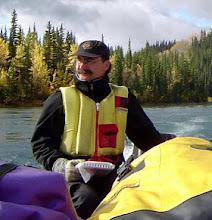I've organized a research team to test a possible environmental history project on the Chilkoot Trail. We are interested to looking at how grasses might have responded to the shock of the gold rush stampede of a century ago. Can vegetation patterns tell us something different than the artifact scatter along the trail. Two members of the team are hiking the trail from Dyea and the ecologist and I will meet them at the Chilkoot Pass summit. We will take the shortcut through “the notch” from the highway in the next valley.
I'd done the notch about ten years earlier and vaguely remembered a sunny passage. This trip was different with low clouds and strong south winds blowing in mist, rain and snow. We started in the sheltered by spruce with both sides of the track thick with ripening blueberries. Clearly the berries are being enjoyed as we walk around the regular and closely distributed blue-tinted signs of bear digestion. Happily our morning passage includes only these, the bears must be off sleeping in the bushes.
At Fraser Lake, we stop to admire the rich patches of high alpine flowers – white grass of parnassus, deep blue gentian and monkshood, red dwarf fireweed, purple saxifrage and yellow arnica and higher up white stika burnet with its catkin like blossoms. Along the rushing water courses we cross as we traverse the steep slopes around the lake we also encounter the delicate purple blossoms of moss campion.
As we clamber over the loose rock scree we are surprised to see a tent on the far shore. On approach, heralded by the loud whistles of unseen marmots further up the mountain side, we meet some friends from Whitehorse. They are relaxing under a small tarp sheltering from the rain which has now started and will accompany us most of the way to the top of the notch. After a short visit we continue along the low wet meadow where we cross and recross the braided creek's meanderings. Our boots gradually fill with water. By the time we clear the meadow onto the higher stoney ground the rain has bulked up the stream and we can longer cross. We follow the windings which takes us below the hanging glacier chilling the valley. By now we've climbed a steep 300 metres in seven kilometres. As we round the last corner we see the saddle just ahead and still another 150 metres above us.
 |
| The author glissades Photo: R. Otfinowski |
At the saddle there is snow driven by a 40 km/hr wind blasting us and stripping away our body heat. We scramble across the ice and weather shattered rock core of the mountain seeking the shelter of the lee slope. Through thick fog ahead, we catch glimpses of Crater Lake and the trail far below. We must drop almost 400 metres in less than a kilometre to reach the trail south to the pass. We do not linger but strike for the long finger of snow just below us. A quick glissade takes us 200 metres downhill, it is the fastest we've moved all day. At the end of the snow we laugh with exhilaration and stagger onto the rocks with jelly legs. From here though its loose rocks and sharp edges to the bottom. Finally at the bottom we hike the last hour up to the Summit cabin where we meet our colleagues and begin the process of drying out, warming up and enjoying a hot supper.
 |
| Chilkoot Pass patrol cabin |



e.jpg)






Looks a little nicer than when we did it in late September. Missed all those gorgeous flowers.
ReplyDeleteLove,
Erin